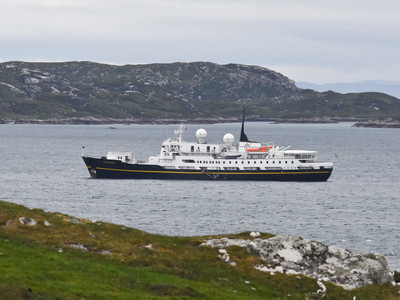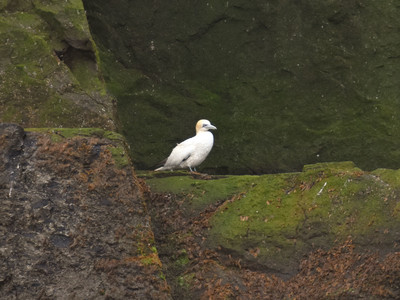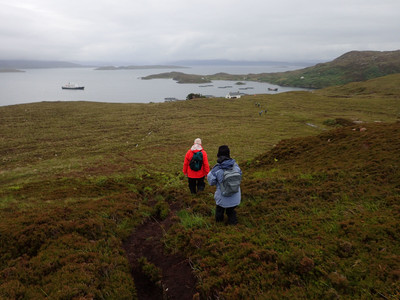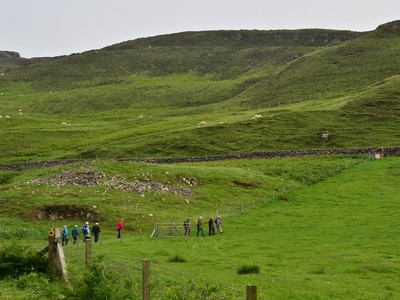Midsummer in the Hebrides
7th to 15th June 2017
MS Serenissima
Wednesday, 7th June 2017 - Embarkation in Oban
Most guests joined the ship travelling by coach from Glasgow, leaving from either the Airport or Central Station. Arriving at the Lighthouse Pier in Oban, we were soon on board the Serenissima for some welcoming refreshment. After settling into our cabins, we assembled in the Andrea Lounge for our Welcome Aboard meeting and our mandatory safety drill, during which we proceeded out on deck to receive our lifejackets and check the route to our respective lifeboats in an emergency. The safety drill over, we began to explore the ship and enjoy the facilities. After some unpacking of suitcases, dinner was served in the Venice Restaurant and we began to get to know our fellow passengers and expedition staff. The ship then sailed out on the 130 mile trip to Iona and the start of our cruise.
Thursday, 8th June 2017 - Iona, Staffa and Lunga

In a fresh wind we landed by Zodiac on a concrete jetty on the small island of Iona just off the west coast of the island of Mull. The first group headed out on a Nature Walk, looking and listening and looking out for the elusive corncrakes. These birds, with their distinctive call, could be heard in the fields though they tended to remain in thick cover for most of the time. Another group headed for the Abbey Church, an impressive building which has been beautifully and carefully conserved. The Communion Table is made of the local Iona marble, white with green streaks. The splendid museum behind the Abbey Church was a must-see stop with carefully displayed grave marker stones and other exhibits.
Having returned to the ship for lunch, we repositioned to Staffa while John gave a commentary about the island and recounted the story of the Scottish and Irish giants. Following an exciting Zodiac ride to land at the small jetty, we took the path around to Fingal’s Cave. Clinging to the handrails, we entered the sea cave a few at a time and marvelled at the amazingly regular hexagonal columns of basalt. Moving on to uninhabited Lunga, the largest of the Treshnish Isles, we landed by Zodiac in calm conditions and climbed the path to see the hundreds of Puffins who walked about on the grass taking nesting material into their burrows. Guillemots and razorbills flew around the cliffs and formed rafts of birds on the surrounding seas.
Friday, 9 June 2017 - St Kilda archipelago
Having sailed overnight from Lunga, we arrived in Village Bay at St Kilda to find good sea conditions for our landing on Hirta, the highlight of the cruise for many of us. A scout Zodiac brought the St Kilda Ranger across to the Serenissima to give us a talk on the history of the island community and to describe the conservation work being carried out on St Kilda by the National Trust for Scotland. Everyone then landed by Zodiac at the jetty and set off on either a long hike up to the gap in the hills behind the village led by James and Joselyn, or accompanied John Love on a more leisurely historical walk around the village. It was fascinating to hear about the hard life of the islanders and see the cottages where they had lived in the bleak landscape. The local brown Soay sheep with their lambs wandered everywhere, completely ignoring our presence. Back on board for lunch, we sailed northwards along the west coast of the archipelago, accompanied by a commentary from John and James along the way.
After passing Soay, we turned eastwards towards Boreray and the massive sea pinnacles of Stac Lee (172m) and Stac an Armin (196m). The former is home to the second largest colony of gannets in the world and Captain Etien Bonačić skilfully navigated the ship around Stac Lee, giving us amazing views of the rocks and birds. After rounding the stacks, we sailed south down the east coast of Boreray and saw some of the feral sheep which roam over the steep grassy slopes of the island. Reaching the southernmost point of the island, we then turned north towards North Rona, our destination for the following day and 113 nautical miles distant. In late afternoon, John Love gave a talk entitled Seabirds and their adaptation to marine life. That evening, Captain Etien Bonačić hosted the Captain’s Welcome Cocktail Party in the Andrea Lounge followed by the Welcome Dinner in the Venice Restaurant. After dinner, we passed the Flannan Islands off the west coast of Lewis, where all three lighthouse keepers mysteriously disappeared during a storm in December 1900.
Saturday, 10th June 2017 - Sula Sgeir and North Rona

Sula Sgeir is one of the most isolated and remote islands in Britain and is home to colonies of gannets and other sea birds. We cruised around the island with its modern automatic light and noted the numerous cairns built around the summit by the bird collectors from Ness, in Lewis, over the years. The numerous small skerries with waves breaking over them emphasised the danger to navigation of this small island group. Leaving Sula Sgeir, James gave a talk entitled Our Dynamic Earth—the story of Plate Tectonics, as we headed for North Rona.
North Rona is a much larger island than Sula Sgeir and had a permanent population of several families before it was abandoned over 150 years ago. There are still extensive lazy beds visible on the grassy slopes and many sheep which run wild for most of the year. The modern research hut is used by visiting scientists studying the sea birds. With sea and weather conditions remaining reasonable, we lowered our Zodiacs and cruised along the massive sea cliffs to see the thousands of sea birds nesting there. Some seals were spotted as we investigated the many sea caves cut into the cliffs. After dinner we set course southwards for the island of Handa, just off the coast of mainland Scotland, a distance of 53 nautical miles.
Sunday, 11th June 2017 - Handa and Inverewe
Having anchored off Handa overnight, we disembarked onto Zodiacs after breakfast for a cruise along the massive vertical cliffs of Torridonian red sandstone. Many of the joints and fissures are being actively eroded by the sea to eventually produce sea stacks, isolated from the main cliff. Close examination of the sandstone beds revealed numerous examples of cross-bedding, a sedimentary feature which indicated that they had originally been deposited in a large braided river system. Large rafts of guillemots and razorbills floating on the surface of the sea appeared oblivious to our presence as we cruised amongst them. After re-embarkation from the Zodiacs, Joselyn gave a talk entitled Secrets of Survival, in which she discussed and illustrated the ways in which nature could teach us about the survival of organisms.
The ship repositioned to Lock Ewe over lunch and we landed by Zodiac onto steps. Despite occasional light rain, we made our way around the maze of paths admiring the great variety of shrubs and temperate plants in a garden originally conceived and created by Osgood Mackenzie from 1862 onwards. After his death in 1922, his daughter continued his work on the gardens until she donated them to the National trust for Scotland in 1952, a year before she died. As well as the exotic plants, Inverewe Gardens are richly endowed with numerous species of lichens, many of which are restricted to, and only thrive in, regions such as the Western Isles where the air is exceptionally clean.
Monday, 12th June 2017 - Tanera Mòr, Summer Isles

Tanera Mòr is the largest of the Summer Isles and is located only a short distance offshore from the mainland of Scotland near the entrance to Loch Broom. We landed by Zodiac on a steel jetty on the sheltered eastern side of the island, facing the village of Achiltibuie. Most of us set off on a hike up a path through the heather to get to the top of Meall Mòr, the highest hill. From there, splendid views were obtained over the rest of the island and across to the mountains on the mainland. An interesting lichen known as Reindeer Moss was seen growing among the heather. The island is composed of Torridonian red sandstone and, from the evidence of glacial striae, was clearly overtopped by the Scottish ice sheet during the last glaciation. After descending from the hill, we visited the small café and shop where some of us purchased the unusual and colourful postage stamps. These are used to pay for the carriage of mail across to the mainland where it is then reposted for onward carriage by Royal Mail.. It is also necessary, of course, to attach the correct UK postage stamps as well!
Over lunch, we sailed for Stornoway, our next port of call and where we would be berthing overnight. On arrival, two Stornoway Cruise Ambassadors came on board and were able to provide maps, leaflets and information about the town and its various places of interest. Afterwards, some of us took the opportunity to walk into town to look around and do some shopping.
Tuesday, 13th June 2017 - Stornoway, Isle of Lewis, and Shiant Islands
The programme for the morning consisted of a coach tour to see some of the well-known tourist sites on Lewis. The impressive Standing Stones of Callanish date back to around 3000BC and consist of a series of megaliths from 1m to 5m in height set upright in a circle 13m in diameter. Avenues of smaller stones are laid out to the four points of the compass across the site. Other smaller stone circles are located nearby. The next stop was at the Carloway Broch, a circular Iron Age stone defensive and domestic building dating from 1AD. The massive stone walls with internal space demonstrated the considerable skills possessed by the builders. This is the bestpreserved broch in Lewis, though there were once many others before they fell into disuse and were pillaged as a source of building stone. Our final venue was the Na Gearrannan Black House Village where a group of traditional style houses have been restored and conserved to show what life was like in the Hebrides only one or two generations ago. The great importance of the peat as a source of locally available fuel was emphasised and it is still used extensively on the island for this purpose. After lunch on board, John Love gave a talk entitled A Saga of Sea Eagles as we repositioned to the Shiant Islands, some 22 nautical miles from Stornoway, and anchored in the bay.
The sea conditions were good as we launched the Zodiacs at the Shiants for cruises along the bird cliffs. These largely consist of tall basaltic columns, some of which had broken off and tumbled down forming a rubble scree perfectly arranged for some of the seabirds to nest.. The calm sea conditions also allowed us to enter some of the amazing sea caves or natural arches cut into the basalt rocks of the archipelago. As we cruised below the towering sea cliffs, Puffins Razorbills and Guillemots flew off in huge numbers and wheeled above, while seals kept popping up their heads to inspect us. After re-embarkation from the Zodiacs, we retired to our cabins to prepare for the Captain’s Farewell Cocktail Party and Dinner, hosted by Captain Etien Bonačić.
Wednesday, 14th June 2017 - Canna and Mull

Once anchored at Canna, we landed by Zodiac in fresh conditions at the concrete slipway where we were met by guides from the National Trust for Scotland. They gave us an account of the human and natural history of the island before we set off on a walk to look at some of the interesting buildings and wildlife. Our enthusiastic guides led us along the quiet tracks and past the unusual small Post Office and St Columba’s Chapel. Walking onto the moorland, the beautifully carved Celtic cross was a reminder of the rich cultural heritage of the Hebrides. Moving back to the main road, we heard about Canna House and the extensive Gaelic library built up by the former owner and Gaelic scholar John Lorne Campbell.
Due to difficult wind and sea conditions, it was decided not to go to Muck as planned but instead to go on to Tobermory on Mull. A tour to see a sea eagle’s nest had been quickly arranged and some of us went ashore by Zodiac and then by bus to that location. Others chose to just walk around the interesting town and do some lastminute shopping, or just visit a café or pub. After dinner, we returned to the Andrea Lounge for the last time to see the Cruise Slideshow ‘You are the Stars’ produced by Pierre. The final event over, we retired to complete our packing ready for disembarkation at Oban the following morning.
End of Voyage
For further inspiration, view slideshow of images taken during the voyage
View all Hebrides Cruises





